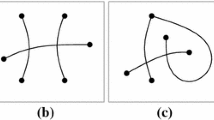Abstract
A funnel, which is notable for its fundamental role in visibility algorithms, is defined as a polygon that has exactly three convex vertices, two of which are connected by a boundary edge. In this paper we investigate the visibility graph of a funnel which we call an F-graph.
We first present two characterizations of an F-graph, one of whose sufficiency proof itself is a linear time Real RAM algorithm for drawing a funnel on the plane that corresponds to an F-graph. We next give a linear-time algorithm for recognizing an F-graph. When the algorithm recognizes an F-graph, it also reports one of the Hamiltonian cycles defining the boundary of its corresponding funnel. This recognition algorithm takes linear time even on a RAM.
We finally show that an F-graph is weakly triangulated and therefore perfect, which agrees with the fact that perfect graphs are related to geometric structures.
Similar content being viewed by others
References
T. Asano, T. Asano, L. Guibas, J. Hershberger, and H. Imai, Visibility of disjoint polygons,Algorithmica,1 (1986), 49–63.
J. Abello, O. Egecioglu, and K. Kumar, Visibility graphs of staircase polygons and the weak Bruhat order, I: From visibility graphs to maximal chains,Discrete Comput. Geom., to appear.
J. Abello, O. Egecioglu, and K. Kumar, Visibility graphs of staircase polygons and the weak Bruhat order, II: From maximal chains to polygons,Discrete Comput. Geom., to appear.
A. V. Aho, J. E. Hopcroft, and J. D. Ullman,The Design and Analysis of Computer Algorithms, Addison-Wesley, Reading, MA, 1974.
D. Avis and G. T. Toussaint, An optimal algorithm for determining the visibility of a polygon from an edge,IEEE Trans. Comput., 30(12) (1981), 910–914.
J. A. Bondy and U. S. R. Murty,Graph Theory with Applications, Elsevier, New York, 1976.
B. Chazelle and L. Guibas, Visibility and intersection problems in plane geometry,Discrete Comput. Geom.,4 (1989), 551–581.
C. Coullard and A. Lubiw, Distance visibility graphs,Proc. 7th ACM Symp. on Computational Geometry, 1991, pp. 289–296. To appear inInternat. J. Comput. Geom. Appl.
H. Everett and D. G. Corneil, Recognizing visibility graphs of spiral polygons,J. Algorithms,11 (1990), 1–26.
H. A. ElGindy, Hierarchical Decomposition of Polygons with Applications, Ph.D. dissertation, School of Computer Science, McGill University, Montreal, 1985.
H. Everett, Visibility Graph Recognition, Ph.D. dissertation, Department of Computer Science, University of Toronto, 1990.
L. Guibas, J. Hershberger, D. Leven, M. Sharir, and R. E. Tarjan, Linear-time algorithms for visibility and shortest path problems inside triangulated simple polygons,Algorithmica,2 (1987), 209–233.
S. K. Ghosh, On Recognizing and Characterizing Visibility Graphs of Simple Polygons, Tech. Report JHU/EECS-86/14, Department of Electrical Engineering and Computer Science, The Johns Hopkins University, Baltimore, MD, 1986. Also as Lecture Notes in Computer Science, Vol. 318, R. Karlsson and A. Lingas, eds., Springer-Verlag, Berlin, 1988.
S. K. Ghosh and D. M. Mount, An output-sensitive algorithm for computing visibility graphs,SIAM J. Comput., 20(5) (1991), 888–910.
M. C. Golumbic,Algorithmic Graph Theory and Perfect Graphs, Academic Press, New York, 1980.
R. B. Hayward, Weakly triangulated graphs,J. Combin. Theory Ser. B,39 (1985), 200–209.
J. Hershberger, An optimal visibility graph algorithm for triangulated simple polygons,Algorithmica,4 (1989), 141–155.
D. S. Johnson, The NP-completeness column: an ongoing guide,J. Algorithms,6 (1985), 434–451.
D. T. Lee and F. P. Preparata, Euclidean shortest paths in the presence of rectilinear barriers,Networks, 14(3) (1984), 393–410.
Y.-L. Lin and S. S. Skiena, Complexity Aspects of Visibility Graphs, Tech. Report, Department of Computer Science, SUNY, Stony Brook, NY, 1992.
J. O'Rourke,Art Gallery Theorems and Algorithms, Oxford University Press, New York, 1987.
J. O'Rourke, Visibility Graphs: a Survey (Computational Geometry Column 18), Tech. Report TR 018, Department of Computer Science, Smith College, Northampton, MA, 1992. Also asInternat. J. Comput. Geom. Appl. 3 (1993), 109–113, and asSIGACT News 24(1) (1993), 20–25.
F. P. Preparata and M. I. Shamos,Computational Geometry, Springer-Verlag, New York, 1985.
G. T. Toussaint, A linear-time algorithm for solving the strong hidden-line problem in a simple polygon,Pattern Recognition Lett.,4 (1986), 449–451.
Author information
Authors and Affiliations
Additional information
Communicated by Takao Nishizeki.
This work was supported in part by the Korea Science and Engineering Foundation under Grant 91-01-01.
Rights and permissions
About this article
Cite this article
Choi, SH., Shin, S.Y. & Chwa, KY. Characterizing and recognizing the visibility graph of a funnel-shaped polygon. Algorithmica 14, 27–51 (1995). https://doi.org/10.1007/BF01300372
Received:
Revised:
Accepted:
Issue Date:
DOI: https://doi.org/10.1007/BF01300372




